2010 SKODA OCTAVIA TOUR seats
[x] Cancel search: seatsPage 88 of 199

Passive Safety87
Using the system
Safety
Driving Tips
General Maintenance
Breakdown assistance
Technical Data
correctly fastened in order to provide an optimal protection for you and your
occupants.
The driver must maintain a distance of
at least 25 cm to the steering wheel
page 86, fig. 89 - left. Not maintaining this minimum distance will mean that
the airbag system will not be able to properly protect you - hazard!
When driving, hold the st eering wheel with both hands firmly on the outer
edge in the 9 o'clock and 3 o'clock po sition. Never hold the steering wheel
firmly in the 12 o'clock position or in another way (e.g. in the middle of the
steering wheel or at the inner steering wheel edge). In such cases, injuries to the
arms, the hands and the head can occur when the driver airbag is deployed.
The seat backrests must not be angled too far back when driving otherwise
this will affect proper operation of the se at belts and of the airbag system - risk
of injury!
Ensure that there are no objects in the footwell as any objects may get
behind the pedals during a driving or braking manoeuvre. You would then no
longer be able to operate the clutch, to brake or accelerate.
Correct seated position for the front passenger
The fro n t p assen ger must mai n tai n a d i stan ce of a t l ea st 25 c m from th e
dash panel so that the airbag offers him the greatest possible safety it is
deployed.For the safety of the front passenger and to reduce the risk of injury in the event of an
accident, we recommend the following setting:
Adjust the front passenger seat as far as possible to the rear.
Adjust the head restraint so that the top edge of the head restraint is at the same
level as the upper part of your head page 86, fig. 89 - right.
Fasten the seat belt correctly page 91, “How are seat belts correctly fastened?”.
In exceptional cases the front pass enger airbag can be deactivated page 101,
“Deactivating an airbag”.
Manual front passenger adjustment page 11, “Adjusting the front seats”.
WARNING
The front seats and the head restraints must always be adjusted to match
the body size of the seat occupant as well as the seat belts must always be
correctly fastened in order to provide an optimal protection for you and your
occupants.
The front passenger must maintain a distance of at least 25 cm to the dash
panel. Not maintaining this minimum distance will mean that the airbag
system will not be able to properly protect you - hazard!
Keep your feet in the footwell at all times while driving. Never place your
feet on the dash panel, out of the window or on the seats. You will be exposed
to increased risk of injury if it becomes necessary to apply the brake or in the
event of an accident. If an airbag is de ployed, you may suffer fatal injuries when
adopting an incorrect seated position!
The seat backrests must not be angled too far back when driving otherwise
this will affect proper operation of the se at belts and of the airbag system - risk
of injury!
Correct seated position for the occupants on the rear seats
Occupants on the rear seats must sit upright, keep the feet in the foot-
well and must have their se at belts correctly fastened.To reduce the risk of injury in the event of a sudden braking manoeuvre or an accident,
the occupants on the rear seats must observe the following:
Adjust the head restraints so that the top edge of the head restraints is at the same
level as the upper part of your head page 86, fig. 89 - on the right.
Fasten the seat belt correctly page 91, “How are seat belts correctly fastened?”.
If you are transporting page 103, “Transporting children safely” children in the
vehicle, please use a suitable child restraint system.
WARNING
The head restraints must always be adjusted to match the body size, in order
to offer an optimal protection for you and your occupants.
WARNING (continued)
s2bs.2.book Page 87 Monday, September 27, 2010 9:53 AM
Page 89 of 199
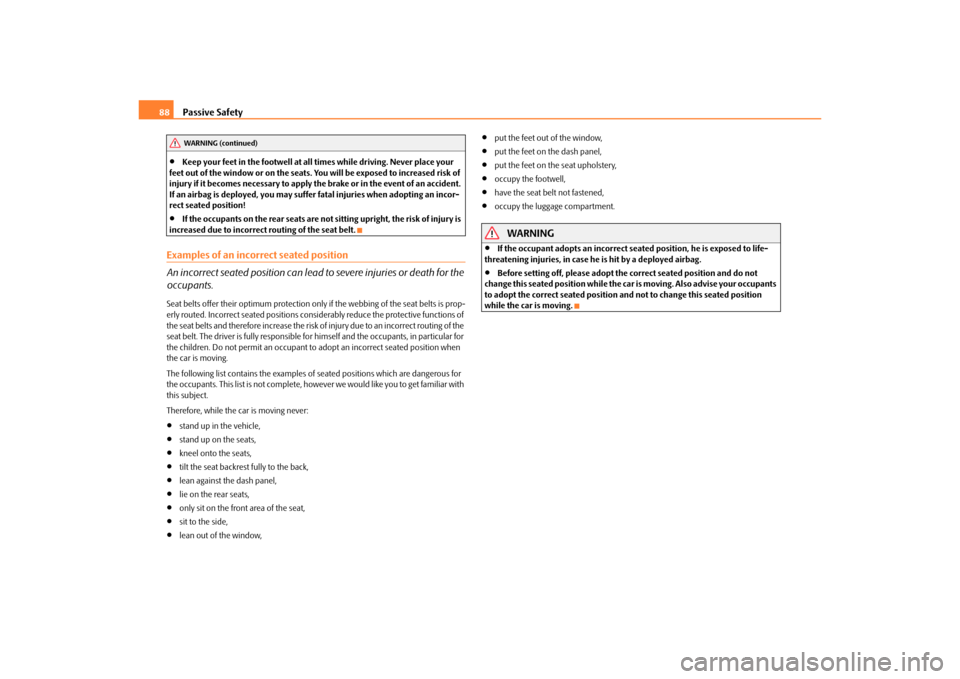
Passive Safety
88
Keep your feet in the footwell at al l times while driving. Never place your
feet out of the window or on the seats. You will be exposed to increased risk of
injury if it becomes necessary to apply the brake or in the event of an accident.
If an airbag is deployed, you may suffer fatal injuries when adopting an incor-
rect seated position!
If the occupants on the rear seats are not sitting upright, the risk of injury is
increased due to incorrect routing of the seat belt.
Examples of an incorrect seated position
An incorrect seated position can lead to severe injuries or death for the
occupants.Seat belts offer their optimum protection only if the webbing of the seat belts is prop-
erly routed. Incorrect seated positions considerably reduce the protective functions of
the seat belts and therefore increase the risk of injury due to an incorrect routing of the
seat belt. The driver is fully responsible for himself and the occupants, in particular for
the children. Do not permit an occupant to adopt an incorrect seated position when
the car is moving.
The following list contains the examples of seated positions which are dangerous for
the occupants. This list is not complete, however we would like you to get familiar with
this subject.
Therefore, while the car is moving never:
stand up in the vehicle,
stand up on the seats,
kneel onto the seats,
tilt the seat backrest fully to the back,
lean against the dash panel,
lie on the rear seats,
only sit on the front area of the seat,
sit to the side,
lean out of the window,
put the feet out of the window,
put the feet on the dash panel,
put the feet on the seat upholstery,
occupy the footwell,
have the seat belt not fastened,
occupy the luggage compartment.
WARNING
If the occupant adopts an incorrect seated position, he is exposed to life-
threatening injuries, in case he is hit by a deployed airbag.
Before setting off, please adopt the correct seated position and do not
change this seated position while the car is moving. Also advise your occupants
to adopt the correct seated position and not to change this seated position
while the car is moving.
WARNING (continued)
s2bs.2.book Page 88 Monday, September 27, 2010 9:53 AM
Page 91 of 199

Seat belts
90
The speed of the vehicle is, nevertheless, the most important factor. Doubling the
speed of the vehicle from 25 km/h up to 50 km/hour increases the kinetic energy four
times.
The common opinion that it is possible to su pport your body in a minor accident with
your hands, is incorrect. Even in a collision at only a low speed, the forces acting on the
body are such that it is no longer possible to support your body.
Even if you only drive at a speed within the range from 30 km/hour to 50 km/hour, the
forces which are produced on your body in the event of an accident can easily exceed
10.000 N (Newton). This equals a weight of one tonne (1 000 kg).
In the event of a frontal collision, occupants of the vehicle not wearing a seat belt, are
thrown forward and strike in an uncontrolled way parts of the interior of the vehicle,
such as steering wheel, dash panel, windscreen, page 89, fig. 91 - left. The occu-
pants of a vehicle who have not fastened their seat belts may even be thrown out of
the vehicle. This can result in fatal injuries.
It is also important that rear seat occupants fasten their seat belts as they will otherwise
be thrown through the vehicle in an uncontr olled manner in the event of an accident
A rear seat passenger who has not fastened the s eat bel t i s a dang er not o nl y to hims elf
but also for those seated at the front page 89, fig. 91 - right.Important safety information regarding the use of seat beltsThe correct use of the seat belts cons iderably reduces the risk of injury!
WARNING
The belt webbing must not be jammed in-between at any point or twisted,
or chafe against any sharp edges.
It is important that the belt webbing is properly routed if the seat belts are
to offer their maximum protection page 91.
No two persons (also not children) should ever use a single seat belt
together.
The maximum protection which seat belts can offer is only achieved if you
are correctly seated page 86, “Correct seated position”.
The belt webbing must not run across solid or fragile objects (e.g. specta-
cles, ball-point pens, keys etc.) as this may be a cause of injuries.
Bulky, loose clothing (e.g. a winter coat over a jacket) does not allow you to
be correctly seated and impairs proper operation of the seat belts.
It is prohibited to use clamps or other objects to adjust seat belts (e.g. for
shortening the belts for smaller persons).
The lock tongue should only be inserted into the lock which is the correct
one for your seat. Wrong use of the safety belt will reduce its capacity to protect
and the risk of injury increases.
The seat backrests of the front seats must not be tilted too far to the rear
otherwise the seatbelts can lose their effectiveness.
The belt webbing must always be kept clean. A soiled belt webbing may
impair proper operation of the inertia reel page 135, “Seat belts”.
The slot of the belt tongue must not be blocked by paper or similar objects
otherwise the belt tongue will not lock in place properly.
Inspect the seat belts regula rly to ensure they are in good condition. If you
find seat belts which have damage to the seat belt webbing, seat belt connec-
tions, to the inertia reels or to the lock, the relevant safety belt must be replaced
by a specialist garage.
The seat belts must not be removed or changed in any way. Do not make an
attempt to repair the seat belts yourself.
Damaged seat belts which have been subjected to stress in an accident and
were therefore stretched, must be replaced - this is best done by a specialist
garage. The anchorage points of the belts must also be inspected. The
anchorage points for the belts should also be checked.
In certain countries it is possible to use seat belts which differ in terms of
their operation from the seat belts which are described on the pages which
follow.WARNING (continued)
s2bs.2.book Page 90 Monday, September 27, 2010 9:53 AM
Page 93 of 199
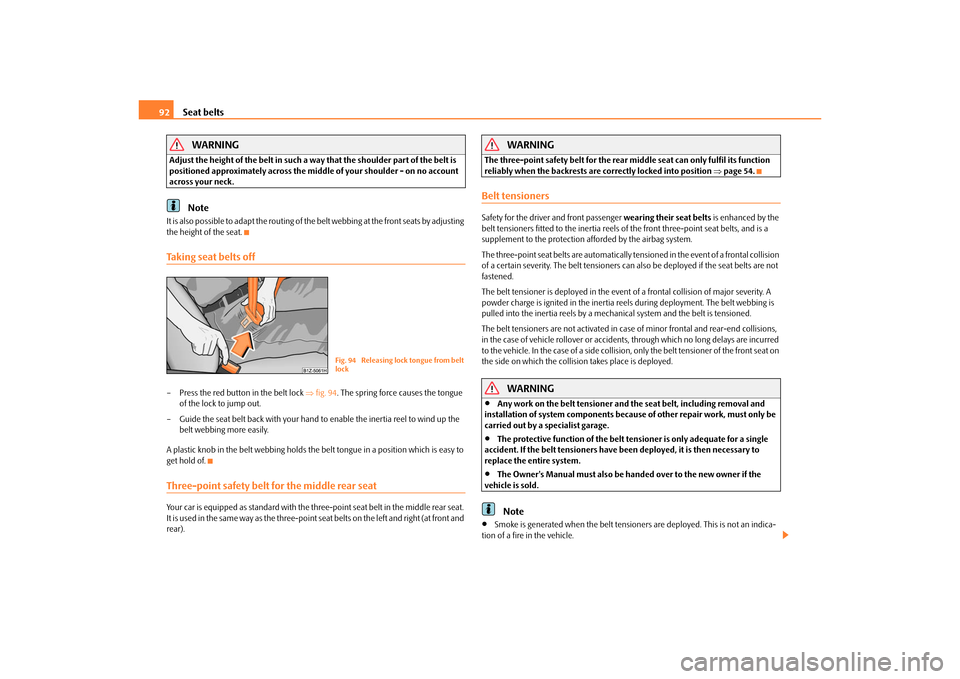
Seat belts
92WARNING
Adjust the height of the belt in such a way that the shoulder part of the belt is
positioned approximately across the middle of your shoulder - on no account
across your neck.
Note
It is also possible to adapt the routing of the belt webbing at the front seats by adjusting
the height of the seat.Taking seat belts off– Press the red button in the belt lock fig. 94 . The spring force causes the tongue
of the lock to jump out.
– Guide the seat belt back with your hand to enable the inertia reel to wind up the
belt webbing more easily.
A plastic knob in the belt webbing holds the be lt tongue in a position which is easy to
get hold of.Three-point safety belt for the middle rear seatYour car is equipped as standard with the three-point seat belt in the middle rear seat.
It i s us ed i n the sam e way as the thre e-poi nt seat belts on the left and right (at front and
rear).
WARNING
The three-point safety belt for the rear middle seat can only fulfil its function
reliably when the backrests are correctly locked into position page 54.Belt tensionersSafety for the driver and front passenger wearing their seat belts is enhanced by the
belt tensioners fitted to the inertia reels of the front three-point seat belts, and is a
supplement to the protection afforded by the airbag system.
The three-point seat belts are automatically te nsioned in the event of a frontal collision
of a certain severity. The belt tensioners can also be deployed if the seat belts are not
fastened.
The belt tensioner is deployed in the event of a frontal collision of major severity. A
powder charge is ignited in the inertia re els during deployment. The belt webbing is
pulled into the inertia reels by a mechanical system and the belt is tensioned.
The belt tensioners are not ac tivated in case of minor frontal and rear-end collisions,
in the case of vehicle rollover or accidents, through which no long delays are incurred
to the vehicle. In the case of a side collision, only the belt tensioner of the front seat on
the side on which the collision takes place is deployed.
WARNING
Any work on the belt tensioner and the seat belt, including removal and
installation of system components because of other repair work, must only be
carried out by a specialist garage.
The protective function of the belt tensioner is only adequate for a single
accident. If the belt tensioners have be en deployed, it is then necessary to
replace the entire system.
The Owner's Manual must also be handed over to the new owner if the
vehicle is sold.Note
Smoke is generated when the belt tensione rs are deployed. This is not an indica-
tion of a fire in the vehicle.
Fig. 94 Releasing lock tongue from belt
lock
s2bs.2.book Page 92 Monday, September 27, 2010 9:53 AM
Page 95 of 199
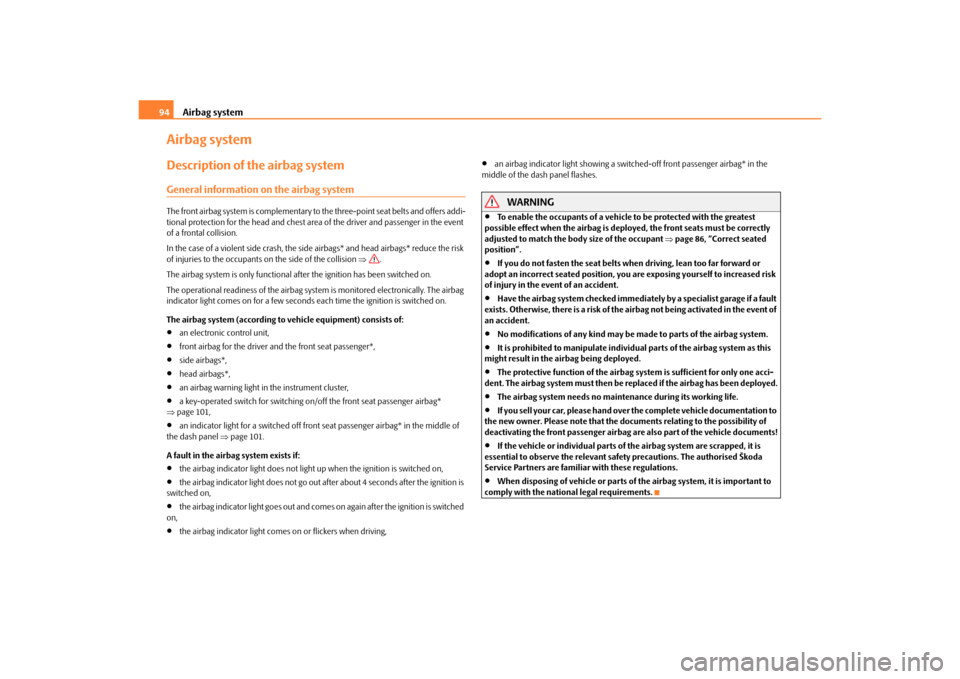
Airbag system
94
Airbag systemDescription of the airbag systemGeneral information on the airbag systemThe front airbag system is complementary to the three-point seat belts and offers addi-
tional protection for the head and chest area of the driver and passenger in the event
of a frontal collision.
In the case of a violent side crash, the side airbags* and head airbags* reduce the risk
of injuries to the occupants on the side of the collision .
The airbag system is only functional af ter the ignition has been switched on.
The operational readiness of the airbag syst em is monitored electronically. The airbag
indicator light comes on for a few seconds each time the ignition is switched on.
The airbag system (according to vehicle equipment) consists of:
an electronic control unit,
front airbag for the driver and the front seat passenger*,
side airbags*,
head airbags*,
an airbag warning light in the instrument cluster,
a key-operated switch for switching on /off the front seat passenger airbag*
page 101,
an indicator light for a switched off fron t seat passenger airbag* in the middle of
the dash panel page 101.
A fault in the airbag system exists if:
the airbag indicator light does not light up when the ignition is switched on,
the airbag indicator light does not go out after about 4 seconds after the ignition is
switched on,
the airbag indicator light goes out and come s on again after the ignition is switched
on,
the airbag indicator light comes on or flickers when driving,
an airbag indicator light showing a switched-off front passenger airbag* in the
middle of the dash panel flashes.
WARNING
To enable the occupants of a vehicle to be protected with the greatest
possible effect when the airbag is depl oyed, the front seats must be correctly
adjusted to match the body size of the occupant page 86, “Correct seated
position”.
If you do not fasten the seat belts when driving, lean too far forward or
adopt an incorrect seated position, you are exposing yourself to increased risk
of injury in the event of an accident.
Have the airbag system checked immediat ely by a specialist garage if a fault
exists. Otherwise, there is a risk of the airbag not being activated in the event of
an accident.
No modifications of any kind may be made to parts of the airbag system.
It is prohibited to manipulate individual parts of the airbag system as this
might result in the airbag being deployed.
The protective function of the airbag system is sufficient for only one acci-
dent. The airbag system must then be re placed if the airbag has been deployed.
The airbag system needs no maintenance during its working life.
If you sell your car, please hand over the complete vehicle documentation to
the new owner. Please note that the documents relating to the possibility of
deactivating the front passenger airbag are also part of the vehicle documents!
If the vehicle or individual parts of the airbag system are scrapped, it is
essential to observe the relevant safety precautions. The authorised Škoda
Service Partners are familiar with these regulations.
When disposing of vehicle or parts of the airbag system, it is important to
comply with the national legal requirements.
s2bs.2.book Page 94 Monday, September 27, 2010 9:53 AM
Page 97 of 199
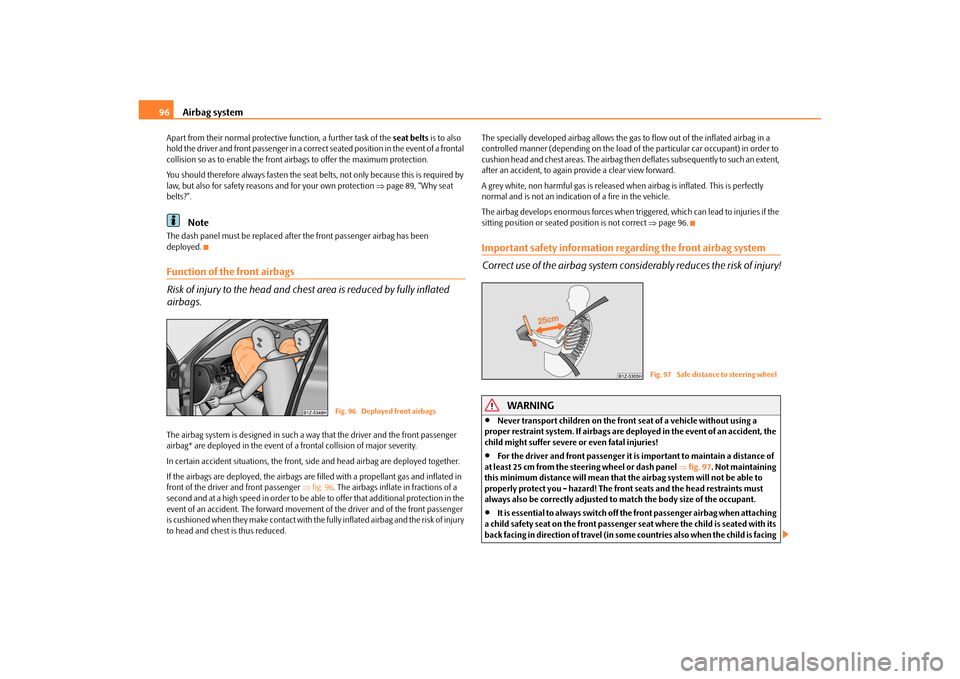
Airbag system
96
Apart from their normal protective function, a further task of the seat belts is to also
hold the driver and front passenger in a correct seated position in the event of a frontal
collision so as to enable the front ai rbags to offer the maximum protection.
You should therefore always fasten the seat be lts, not only because this is required by
law, but also for safety reasons and for your own protection page 89, “Why seat
belts?”.
Note
The dash panel must be replaced after the front passenger airbag has been
deployed.Function of the front airbags
Risk of injury to the head and ches t area is reduced by fully inflated
airbags.The airbag system is designed in such a way that the driver and the front passenger
airbag* are deployed in the event of a frontal collision of major severity.
In certain accident situ ations, the front, side and head airbag are deployed together.
If the airbags are deployed, the airbags are filled with a propellant gas and inflated in
front of the driver and front passenger fig. 96 . The airbags inflate in fractions of a
second and at a high speed in order to be able to offer that additional protection in the
event of an accident. The forward movement of the driver and of the front passenger
is cushioned when they make contact with the fully inflated airbag and the risk of injury
to head and chest is thus reduced. The specially developed airbag allows the gas
to flow out of the inflated airbag in a
controlled manner (depending on the load of the particular car occupant) in order to
cushion head and chest areas. The airbag then deflates subsequently to such an extent,
after an accident, to again provide a clear view forward.
A grey white, non harmful gas is released when airbag is inflated. This is perfectly
normal and is not an indicati on of a fire in the vehicle.
The airbag develops enormous forces when triggered, which can lead to injuries if the
sitting position or seated position is not correct page 96.
Important safety information regarding the front airbag system
Correct use of the airbag system cons iderably reduces the risk of injury!
WARNING
Never transport children on the front seat of a vehicle without using a
proper restraint system. If airbags are de ployed in the event of an accident, the
child might suffer severe or even fatal injuries!
For the driver and front passenger it is important to maintain a distance of
at least 25 cm from the steering wheel or dash panel fig. 97 . Not maintaining
this minimum distance will mean that the airbag system will not be able to
properly protect you - hazard! The front seats and the head restraints must
always also be correctly adjusted to match the body size of the occupant.
It is essential to always switch off th e front passenger airbag when attaching
a child safety seat on the front passenger seat where the child is seated with its
back facing in direction of travel (in some countries also when the child is facing
Fig. 96 Deployed front airbags
Fig. 97 Safe distance to steering wheel
s2bs.2.book Page 96 Monday, September 27, 2010 9:53 AM
Page 98 of 199
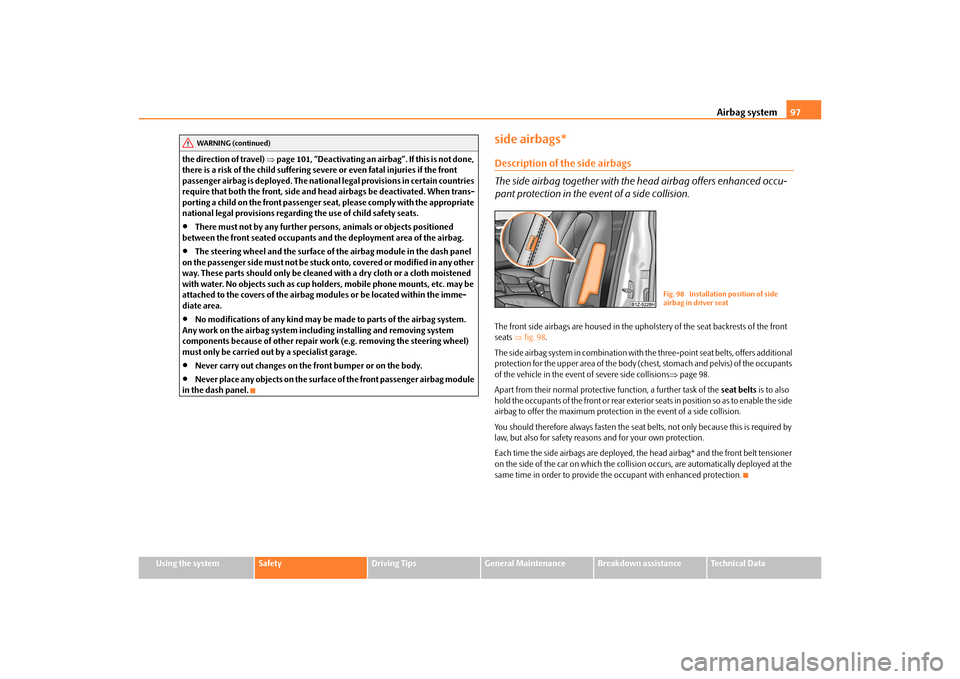
Airbag system97
Using the system
Safety
Driving Tips
General Maintenance
Breakdown assistance
Technical Data
the direction of travel)
page 101, “Deactivating an airbag”. If this is not done,
there is a risk of the child suffering seve re or even fatal injuries if the front
passenger airbag is deployed. The national legal provisions in certain countries
require that both the front, side and head airbags be deactivated. When trans-
porting a child on the front passenger se at, please comply with the appropriate
national legal provisions regarding the use of child safety seats.
There must not by any further persons, animals or objects positioned
between the front seated occupants and the deployment area of the airbag.
The steering wheel and the surface of the airbag module in the dash panel
on the passenger side must not be stuck onto, covered or modified in any other
way. These parts should only be cleaned with a dry cloth or a cloth moistened
with water. No objects such as cup holders, mobile phone mounts, etc. may be
attached to the covers of the airbag modules or be located within the imme-
diate area.
No modifications of any kind may be made to parts of the airbag system.
Any work on the airbag system includ ing installing and removing system
components because of other repair wo rk (e.g. removing the steering wheel)
must only be carried out by a specialist garage.
Never carry out changes on the front bumper or on the body.
Never place any objects on the surface of the front passenger airbag module
in the dash panel.
side airbags*Description of the side airbags
The side airbag together with the head airbag offers enhanced occu-
pant protection in the event of a side collision.The front side airbags are housed in the upholstery of the seat backrests of the front
seats fig. 98 .
The side airbag system in combination with the three-point seat belts, offers additional
protection for the upper area of the body (chest, stomach and pelvis) of the occupants
of the vehicle in the event of severe side collisions page 98.
Apart from their normal protective function, a further task of the seat belts is to also
hold the occupants of the front or rear exterior seats in position so as to enable the side
airbag to offer the maximum protection in the event of a side collision.
You should therefore always fasten the seat belts, not only because this is required by
law, but also for safety reasons and for your own protection.
Each time the side airbags are deployed, th e head airbag* and the front belt tensioner
on the side of the car on which the collision occurs, are automatically deployed at the
same time in order to provide the occupant with enhanced protection.
WARNING (continued)
Fig. 98 Installation position of side
airbag in driver seat
s2bs.2.book Page 97 Monday, September 27, 2010 9:53 AM
Page 99 of 199
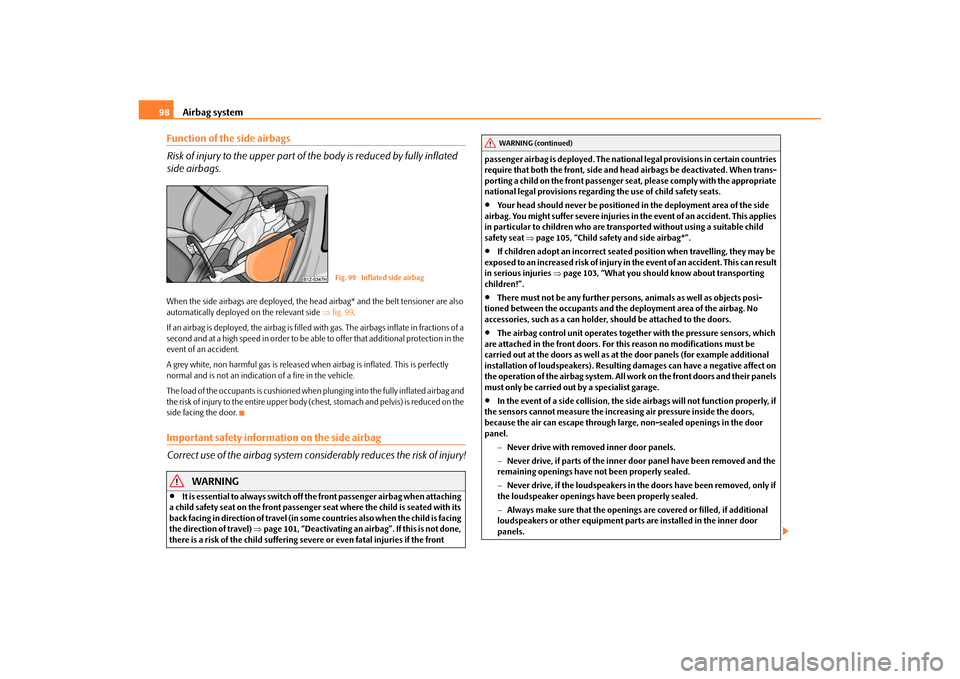
Airbag system
98
Function of the side airbags
Risk of injury to the upper part of the body is reduced by fully inflated
side airbags.When the side airbags are deployed, the head airbag* and the belt tensioner are also
automatically deployed on the relevant side fig. 99 .
If an airbag is deployed, the airbag is filled with gas. The airbags inflate in fractions of a
second and at a high speed in order to be able to offer that additional protection in the
event of an accident.
A grey white, non harmful gas is released when airbag is inflated. This is perfectly
normal and is not an indicati on of a fire in the vehicle.
The load of the occupants is cushioned when plunging into the fully inflated airbag and
the risk of injury to the entire upper body (chest, stomach and pelvis) is reduced on the
side facing the door.Important safety information on the side airbag
Correct use of the airbag system cons iderably reduces the risk of injury!
WARNING
It is essential to always switch off the front passenger airbag when attaching
a child safety seat on the front passenger seat where the child is seated with its
back facing in direction of travel (in some countries also when the child is facing
the direction of travel) page 101, “Deactivating an airbag”. If this is not done,
there is a risk of the child suffering seve re or even fatal injuries if the front passenger airbag is deployed. The national
legal provisions in certain countries
require that both the front, side and head airbags be deactivated. When trans-
porting a child on the front passenger seat, please comply with the appropriate
national legal provisions regardin g the use of child safety seats.
Your head should never be positioned in the deployment area of the side
airbag. You might suffer severe injuries in the event of an accident. This applies
in particular to children who are transported without using a suitable child
safety seat page 105, “Child safety and side airbag*”.
If children adopt an incorrect seated position when travelling, they may be
exposed to an increased risk of injury in the event of an accident. This can result
in serious injuries page 103, “What you should know about transporting
children!”.
There must not be any further persons, animals as well as objects posi-
tioned between the occupants and the deployment area of the airbag. No
accessories, such as a can holder, should be attached to the doors.
The airbag control unit operates togeth er with the pressure sensors, which
are attached in the front doors. For this reason no modifications must be
carried out at the doors as well as at the door panels (for example additional
installation of loudspeakers). Resulting damages can have a negative affect on
the operation of the airbag system. All work on the front doors and their panels
must only be carried out by a specialist garage.
In the event of a side collision, the side airbags will not function properly, if
the sensors cannot measure the increasi ng air pressure inside the doors,
because the air can escape through lar ge, non-sealed openings in the door
panel.
Never drive with removed inner door panels.
Never drive, if parts of the inner do or panel have been removed and the
remaining openings have not been properly sealed.
Never drive, if the loudspeakers in the doors have been removed, only if
the loudspeaker openings have been properly sealed.
Always make sure that the openings are covered or filled, if additional
loudspeakers or other equipment part s are installed in the inner door
panels.
Fig. 99 Inflated side airbag
WARNING (continued)
s2bs.2.book Page 98 Monday, September 27, 2010 9:53 AM